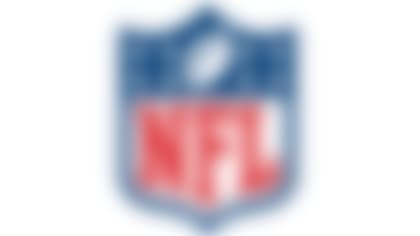FORT LAUDERDALE, Fla. -- This much can be said with certainty: A team doesn't need to run well to reach the Super Bowl.
Last year, the Arizona Cardinals got there with the NFL's worst rushing attack.
This year, it's the Indianapolis Colts that hold that not-so-proud distinction.
What the rankings don't indicate, however, is that a significant part of both clubs' postseason success resulted from showing some signs of life on the ground in the playoffs. For the Cardinals -- whose fortunes were still firmly attached to Kurt Warner's passing arm -- it wasn't quite enough to allow them to beat the Pittsburgh Steelers in Super Bowl XLIII.
The Colts have no illusions about winning Super Bowl XLIV without a whole lot of big throws from Peyton Manning, either. However, they're not willing to concede that their running game will be invisible against the New Orleans Saints.
"Our desire, with respect to the running game, is to run effectively," Colts president Bill Polian said. "It is not to create statistics. We're always going to throw the ball more than we run it and if teams play us in certain ways, because of the flexibility that Peyton has (to change plays) at the line of scrimmage, the likelihood is that there's a higher incidence of throws.
"So what you want to do is run effectively."
For most of the Colts' 14-2 regular season, and in their 20-3 divisional-round playoff victory over the Ravens, that meant running just enough to keep defenses honest. Despite minimal gains, they at least established a willingness to run occasionally, forcing opponents to honor their ground game.
In their 30-17 AFC Championship Game triumph over the New York Jets, the Colts did more than use their running game as some sort of mild diversionary tactic. They actually ran with success, gaining 101 yards against the NFL's top-ranked defense, while holding the Jets' league-leading rushing attack to just 86 yards. Joseph Addai finished with a game-high 80 yards and an impressive 5.0 yard per carry average against the Jets.
The Saints have one of the stronger ground games in the league, and it's natural to presume that they can do a better job than the Colts at controlling the ball. But the Colts, who are looking to become the first team to win the Super Bowl with the worst regular-season run production, have reason to believe they can build on what they did against the Jets well enough to have a little offensive balance of their own.
"Any time you get a chance to run the ball well it builds confidence," Addai said. "And having a good running game against the Jets going into the Super Bowl brings confidence not only for the running backs but the whole team."
The Jets' blitz-oriented defense presented multiple opportunities for long gains on the ground. Making the most of his incredible knack for anticipating blitzes well before the snap, Manning could see when the Jets' run defense was particularly vulnerable and would change the play accordingly. As a result, Addai had runs of 17 and 16 yards, along with a 9-yard carry and a couple of 8-yard pops. Rookie Donald Brown had a 12-yard gain.
"Any time a team is going to start blitzing you, as long as you can get (the blitzers) identified and picked up, there's opportunity for big plays, whether it be pass or run," offensive tackle Ryan Diem said. "Obviously, with Peyton, we're going to try to take advantage of some of those opportunities. He sees those things so well, I can't even explain it. He sees the blitzes before they happen and he knows what's coming."
The Colts have solid enough backfield talent to fit their pass-happy scheme. Addai, who joined the team as a first-round draft pick from LSU in 2006, led the team in the regular season with 828 rushing yards and averaged a respectable 3.8 yards per carry. He has excellent field vision, good elusiveness and has been healthier after undergoing offseason knee surgery.
Addai did deal with some bumps and bruises during the 2009 season, and returned to action after heading to the locker room with a shoulder injury in the AFC title game. When the Coltsbeat the Bears in their previous Super Bowl appearance after the '06 season, Addai, then a rookie, contributed 143 yards from scrimmage (77 rushing and 66 receiving on 10 catches).
Brown, a first-rounder from Connecticut, finished the regular season with 281 rushing yards and a 3.6-yards-per-carry average. He has breakaway speed and strong receiving skills. Second-year man Mark Hart is a solid short-yardage and goal-line runner, whose role is expected to expand in the future.
The Colts' offensive line is known, first and foremost, for its exceptional pass protection. It allowed an NFL-low 13 sacks during the regular season, and Manning, who was brought down only 10 times, is rarely ever touched. This group doesn't get any recognition for getting push in the running game, although it did demonstrate a surprising ability to impose its will on the Jets' physical front seven with a conference crown at stake.
"We know, when it's third-and-2 or third-and-1 and we need it, we're going to do everything we can to make sure we move those chains," Diem said. "Our mindset is not necessarily always to get big chunks in the passing game, but just to stay in rhythm, stay in phase, and if it comes down to third-and-short, just get that first. Move the chains and start over."
"Our system requires that the tailback be a very, very good blocker," Polian said. "You wouldn't get on the field unless you could do the blitz pickup. That's a little different maybe than a team that features a back in the I-formation and you toss him the ball and he's got a fullback in front of him and things of that nature. And our backs get involved in some horrendous collisions with linebackers and sometimes even defensive ends. So it's a position that wears on you pretty hard."
As far as Manning is concerned, no one has handled the challenges of playing the position for the Colts -- as well as the challenge created by investing a first-round choice on a player at his position -- better than Addai.
"Addai has been great," Manning said. "He's had a tremendous attitude. He's done everything the team has asked of him. He hasn't been 100-percent healthy, but he's played through injuries. That speaks to his toughness.
"He has pass-protected brilliantly. He's made huge first downs. He and Donald have worked into a nice rotation, which I think only makes both of them better. There is no way we'd be where we are in this game without the play of Addai this year."
Still, one fairly large concern for the Colts is their inability to consistently run an effective "4-minute offense," where they can kill off the clock at the end of the game and keep the ball away from the opponent. They did do a good job of that in the AFC Championship Game, but there remains a tremendous amount of room for improvement.
"It's hard to get a rhythm when you only run 12-15 times a game," Diem said. "We don't run the ball often enough to kind of feel that run rhythm that maybe some other teams do."
The struggles of the Colts' running game have led to criticism of everyone involved. Most of it has been directed at Addai.
He seems to take it all in stride, in large part because he knows that it comes with the territory when you're part of the 32nd-ranked rushing attack in a 32-team league.
"I'm human, but at the same time, you've got a chance every Sunday to go prove yourself," Addai said. "Do I feel like I bring something to the table? Yes, I feel like I bring something to the table. Numbers? The numbers are not where we want them, but I think, when we do run the ball, we do have a good chance of making yardage or making something happen."



